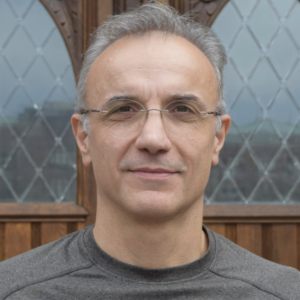
Behçet Açikmeşe (Professor, University of Washington)
A new episode of the Computing Community Consortium‘s (CCC) official podcast, Catalyzing Computing, is now available. In this episode, Khari Douglas (CCC Senior Program Associate) interviews Dr. Behçet Açikmeşe. Behçet was a technologist and a senior member of the Guidance and Control (G&C) Analysis Group at NASA Jet Propulsion Laboratory (JPL) from 2003 to 2012 where he developed guidance, control, and estimation algorithms for formation-flying spacecraft and distributed networked systems, proximity operations around asteroids and comets, and planetary landing. He is currently a Professor in Aeronautics & Astronautics, as well as Electrical & Computer Engineering, at the University of Washington and a member of their Autonomous Controls Lab.
In this episode, Dr. Açikmeşe discuss his time at JPL and what it takes to land a rover on Mars. Below is a highlight from the discussion, taken from the transcript of the podcast, about Behçet’s contribution to landing the Mars Curiosity Rover. It is lightly edited for readability.
[Catalyzing Computing Episode 31 – starting at 16:04]
Khari: So the algorithms that you, specifically, were working on — what were those focused around?
Behçet: Oh, the algorithm that I worked on was responsible for the fly-away phase of the mission. What happened on the Mars Science Lab (MSL) mission is the following: as I said, we enter the atmosphere, we slow down with drag forces, then we open the parachute — it’s called supersonic parachute because we open it at supersonic speeds. That brings us more or less below supersonic speeds. Maybe I’m lying here? It may still be supersonic, but it slows it down even further. Then there’s a point at which we cut the parachute off and we turn on the engines, the thrusters. They slow us down and as we come down this is called the “powered descent phase.” “Powered” because we have the thrusters on.
We are about tens of meters above the ground when we start really slowing down. We are coming down very gently now. There’s a winch on board, which has cables, and this winch lowers the rover down with the cables. The descent vehicle is hovering over the ground at that stage. When the rover touch down is detected, the algorithm that I designed takes over and stabilizes the descent vehicle during that time, because there’s an offload — suddenly, you are carrying the load of the rover, which is almost the same mass as the descent vehicle, and when the rover touches the ground, suddenly, you don’t have that load. It’s like, you drop something, then you will have a transitional effect during that time.
Then, once that happens and when we know that the rover is safe on the ground, the cable was cut and the vehicle had to turn and burn at the same time to fly away from the rover and crash as far as possible. That was the responsibility of the controller that I designed. My job was literally to generate the first man-made crater on Mars.
[Laughter]
That’s a pretty accurate description I would say. So the tricky part of the algorithm was how you stabilize the vehicle during the contact and then turn it. When you’re turning it you have to be really careful. If you turn wobbling, the thrust coming out of the thrusters can cause a lot of trouble for the vehicle — it can affect the sensitive sensors on the rover and such. So I had to really tightly control this thing and push it as I’m turning it. It’s like throwing a javelin or something, you are pushing it as hard as you can. I had, literally, several seconds to push it as hard as I can, and then it’s on a course to fly as far as possible, basically. And I made it fly around 650 meters from the landing location, which was great because my requirement was about 200 meters. I did it with a major margin and by using the allocated fuel.
[Laughter]
That was really successful in that way. It crashed and then they took a picture from the Mars orbiting satellite. You could see the landing site and the crash site. It was a beautiful picture, maybe I should send you after the podcast.
Khari: Yeah, if you send it to me when I announce the podcast, I’ll post a photo somewhere. [View the photo here]
Listen to the full interview with Dr. Açikmeşe in the embedded player below or find it on Apple Podcasts | Spotify | Stitcher | Blubrry | Google Podcasts | iHeartRadio | Youtube. If you prefer to read rather than listen, the transcript of the interview is available here. Part two of the interview will be released next Monday (March 8th).
https://soundcloud.com/compcomcon/autonomous-flight-and-landing-on-mars-with-behcet-acikmese-part-1/s-70BP0jVolQs
Timestamps to jump to certain topics below:
- Intro – 0:00
- Background and Joining NASA’s Jet Propulsion Laboratory – 01:23
- Landing a Rover on Mars – 06:00
- Other Projects at JPL – 19:46
- Sensors on Spacecraft – 27:10
- Landing on Earth vs. Mars – 31:42
- Working at JPL and Career Advice – 33:55
- Outro – 40:56
If you are interested in appearing in an episode of the Catalyzing Computing podcast or want to contribute a guest post to the CCC blog, please complete this survey through Google Forms.
If you listen to the podcast, please take a moment to complete this listener survey – this survey will help us learn more about you and better tailor the show to the interests of our listeners.









